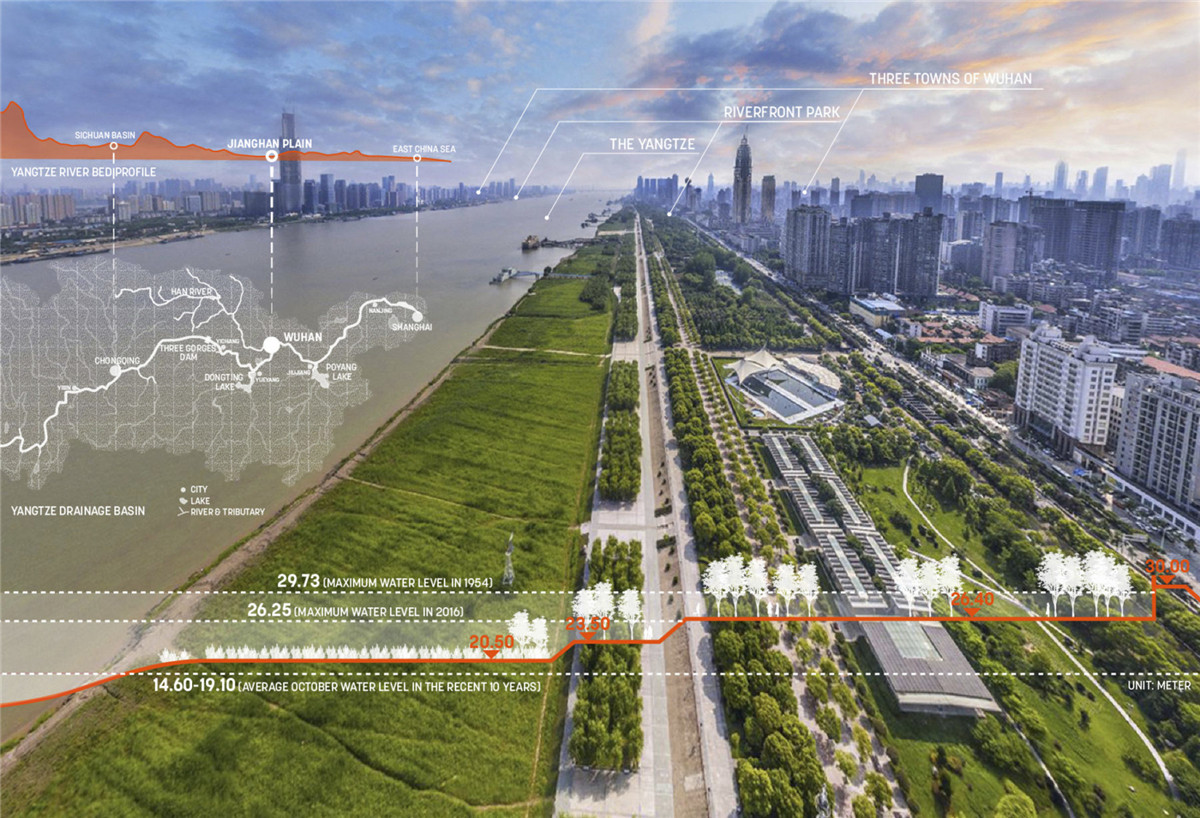
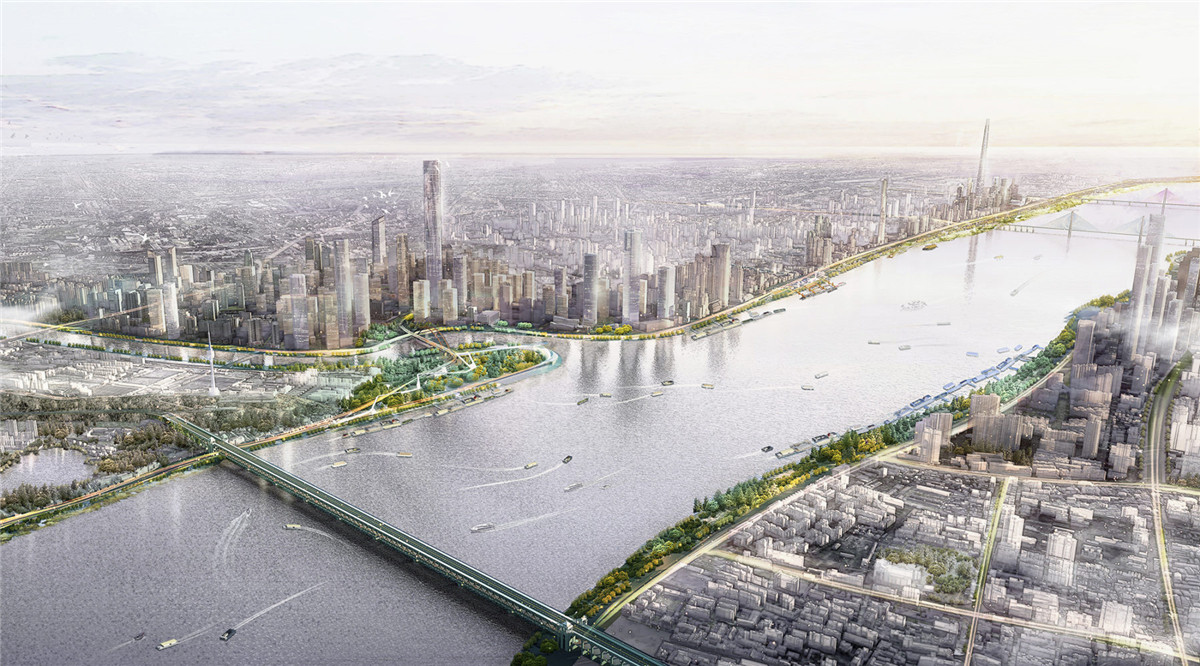
The Yangtze is Asia’s longest river and drains one-fifth of China’s land area. Revered as the “mother river,” it has nurtured China’s history, culture, and economy since the dawn of civilization. This relationship between the people and the river has, in recent years, grown tense. Despite unprecedented advancements in engineering, all major cities on the Yangtze increasingly suffer from mounting flooding damage—demonstrating that the river is far from tamable.
长江是亚洲最长的河流,流经中国陆地面积的五分之一。被誉为“母亲河”,自文明之初,它就孕育了中国的历史、文化和经济。近年来,人与河流之间的这种关系变得紧张。尽管在工程方面取得了前所未有的进步,但长江上的所有主要城市都越来越多地遭受洪水破坏——这表明这条河流远非可驯服。
Emerging because of its relationship with the Yangtze, central China’s largest city of Wuhan has coevolved with the river so symbiotically for the past 1,800 years that every milestone in its history has been tied to the river. Centuries of floods created fertile land for the early settlers, and high water safeguarded the birth of the city. As Wuhan has emerged as one of China’s hotbeds for technology, education, and innovation, land prices have soared and the city faces rising conflicts between development pressures and public demand for open space. It is striving to explore new ways of embracing the river after nearly a century of industrial exploitations and urban expansion.
由于与长江的关系而崛起,中国中部最大的城市武汉在过去的 1800 年里与河流共存共生,其历史上的每一个里程碑都与河流有关。数百年的洪水为早期定居者创造了肥沃的土地,高水位保障了城市的诞生。随着武汉成为中国科技、教育和创新的温床之一,地价飙升,城市面临着发展压力与公共空间需求之间日益加剧的冲突。经过近一个世纪的工业开发和城市扩张,它正在努力探索拥抱河流的新方式。
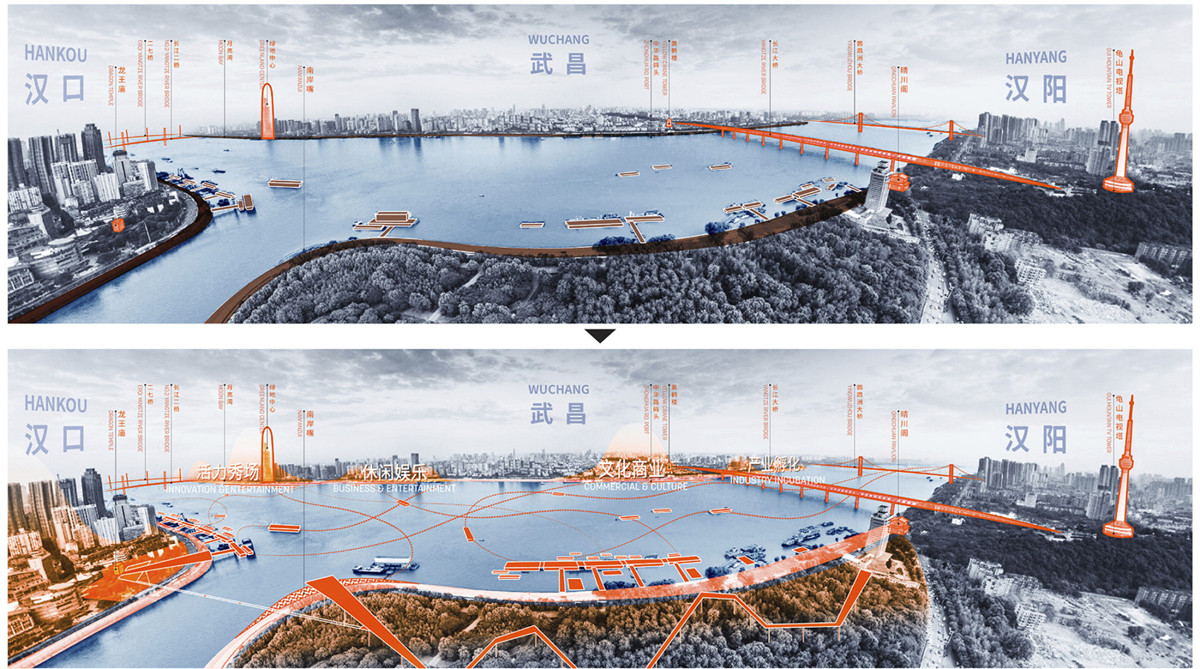
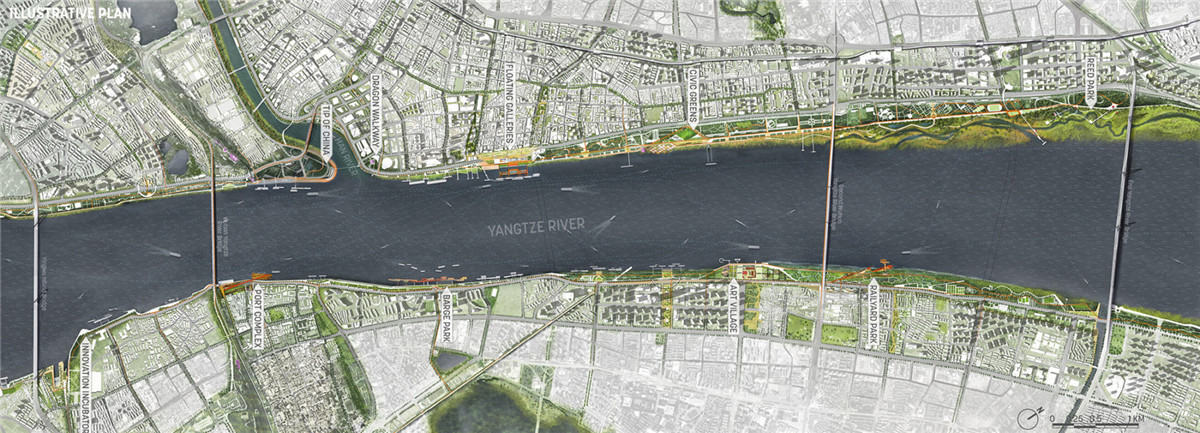


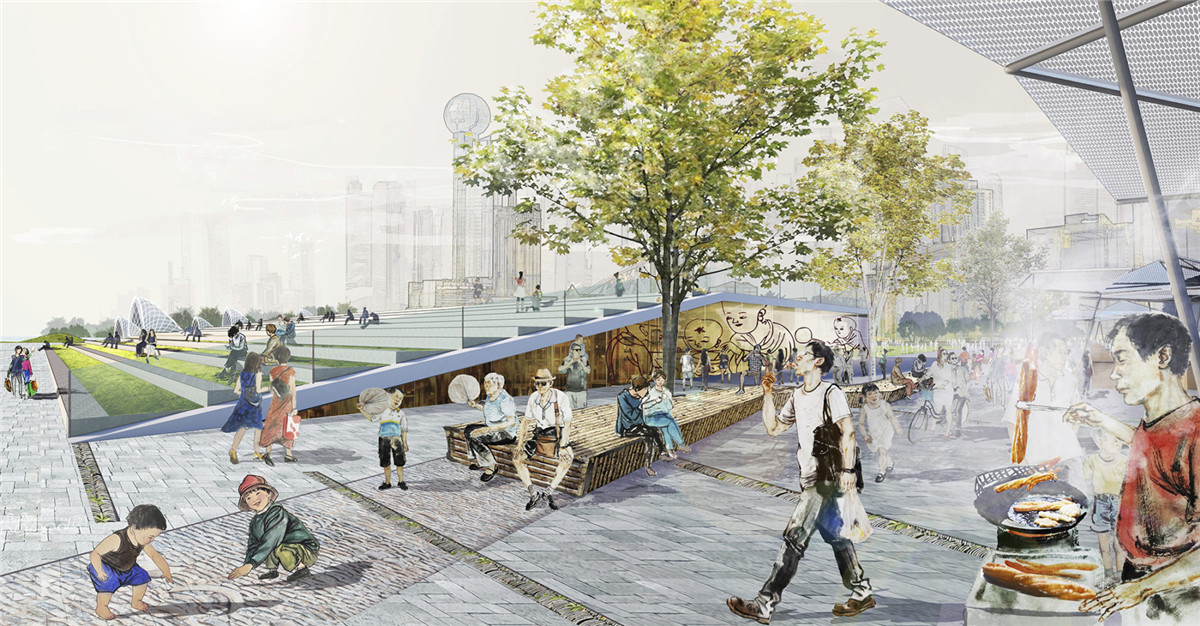
This “river culture” is so deeply embedded in Wuhan that today people still frequent the riverfront parks even when they are flooded—enjoying the rare excitement of such intimate contact with the water. The design of the park celebrates this strong river culture and leverages frequent flooding events as a vital driver of placemaking strategies. Much of the programming along the river is designed to celebrate the river’s spontaneity and incorporate its flooding as an essential element of the ever-changing landscape.
这种“河文化”在武汉根深蒂固,以至于今天人们即使在被洪水淹没的情况下仍然经常光顾河滨公园——享受着与水亲密接触的难得的刺激。公园的设计颂扬了这种强大的河流文化,并利用频繁的洪水事件作为场所营造策略的重要推动力。沿河的大部分规划旨在庆祝河流的自发性,并将其洪水作为不断变化的景观的基本要素。
The river’s mudflats continue to play a critical role in supporting biodiversity and delivering crucial ecosystem services, but the sediment flux of the Yangtze River has dropped tremendously due to numerous upstream hydrological projects along the river. The rapid disappearance of these mudflats places regional biodiversity in jeopardy. Through strategic dredging and grading, the design creates heterogeneous microenvironments that host a wide variety of distinct wetland ecosystems in the mudflats. Nuanced topography, coupled with the river’s frequent water level fluctuations, enable complex plant communities to grow. From emergent marshlands to vernal pools, these typologies create an evolving landscape character throughout the year.
长江的泥滩在支持生物多样性和提供重要的生态系统服务方面继续发挥着关键作用,但由于沿江上游的众多水文工程,长江的泥沙通量已大幅下降。这些泥滩的迅速消失使区域生物多样性处于危险之中。通过战略疏浚和分级,该设计创造了异质微环境,在泥滩中容纳各种不同的湿地生态系统。微妙的地形加上河流频繁的水位波动,使复杂的植物群落得以生长。从新出现的沼泽地到春季水池,这些类型在一年中创造了不断变化的景观特征。


A series of sinuous secondary streams are graded to emerge in the mudflats during mid-high water levels, and provide alternative passages for aquatic wildlife, as well as safe corridors for kayaking. This strategy creates a tranquil experience amid tall marsh grasses, even when the Yangtze’s waters roar. During dry months, these stream beds function as informal pathways for visitors to explore, slicing through the dense grasses.
一系列蜿蜒的溪流在中高水位时出现在泥滩中,为水生野生动物提供替代通道,以及皮划艇的安全走廊。这种策略在高大的沼泽草丛中创造了一种宁静的体验,即使长江的水在咆哮。在干旱的月份,这些河床作为游客探索的非正式通道,穿过茂密的草丛。
Alongside logs for turtles to loaf on and submerged fish structures, waterfowl nesting platforms are installed in the open marsh. Discreet birding stations within the tree groves offer viewing opportunities for wildlife enthusiasts. Recreational spaces are arranged based on careful calculations of the dispersing distances for the key wildlife species in the river basin such that they do not intrude into the primary habitats. During floods, the recreational fields in the mudflats are temporarily returned to the river and repopulated by fish and waterfowl.
除了供龟游荡和淹没鱼类结构的原木外,水禽筑巢平台还安装在开阔的沼泽中。树丛中隐蔽的观鸟站为野生动物爱好者提供了观赏机会。休闲空间是根据流域内主要野生动物物种的分散距离的仔细计算来安排的,这样它们就不会侵入主要栖息地。在洪水期间,泥滩中的休闲场地会暂时返回河流,并重新养育鱼类和水禽。
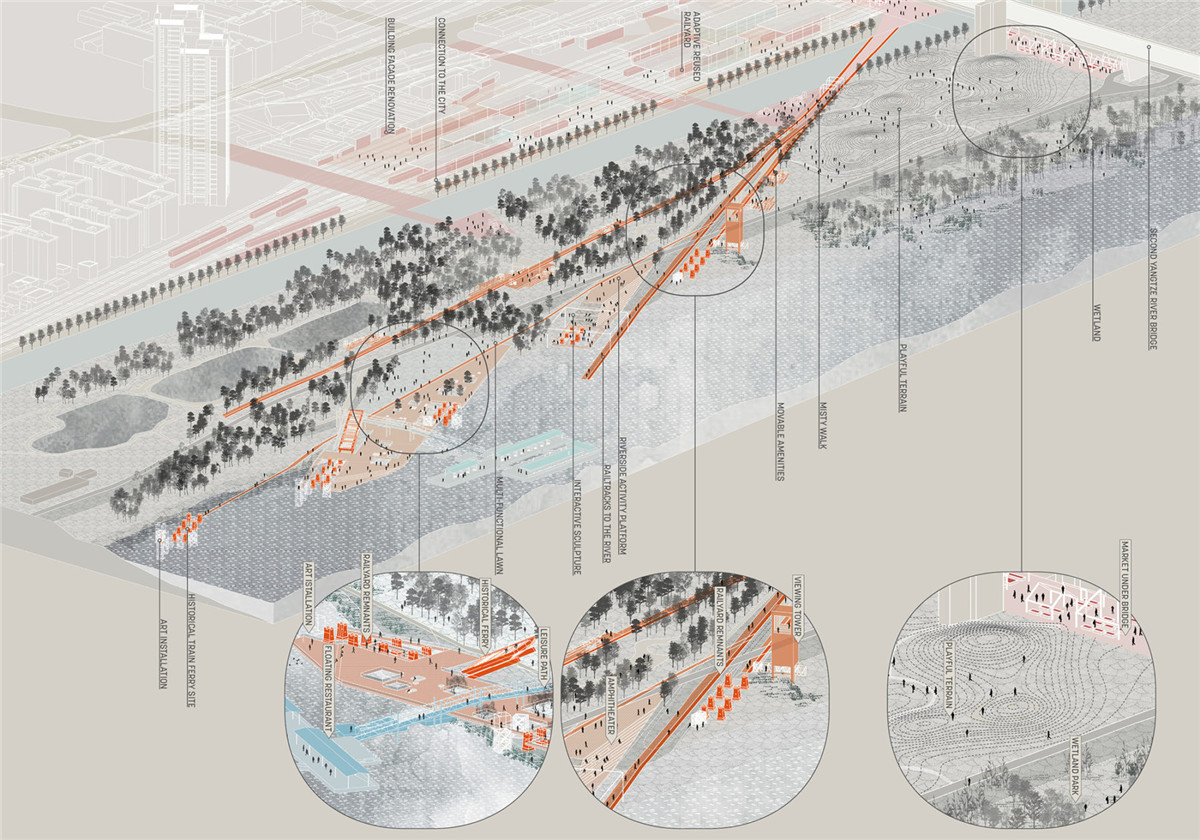
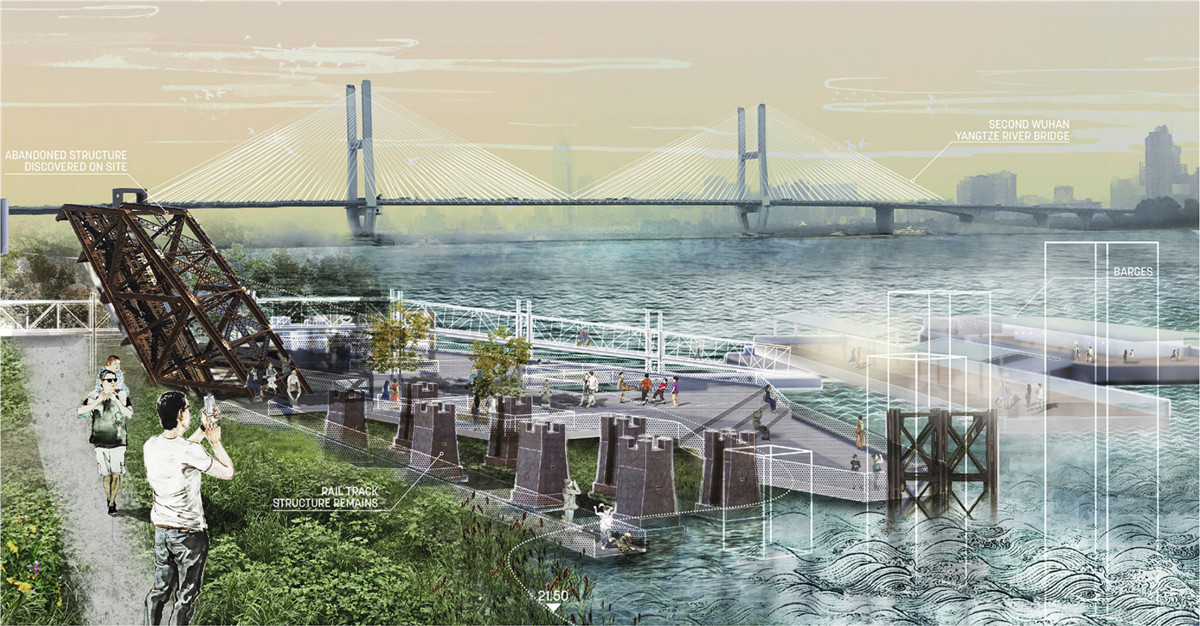
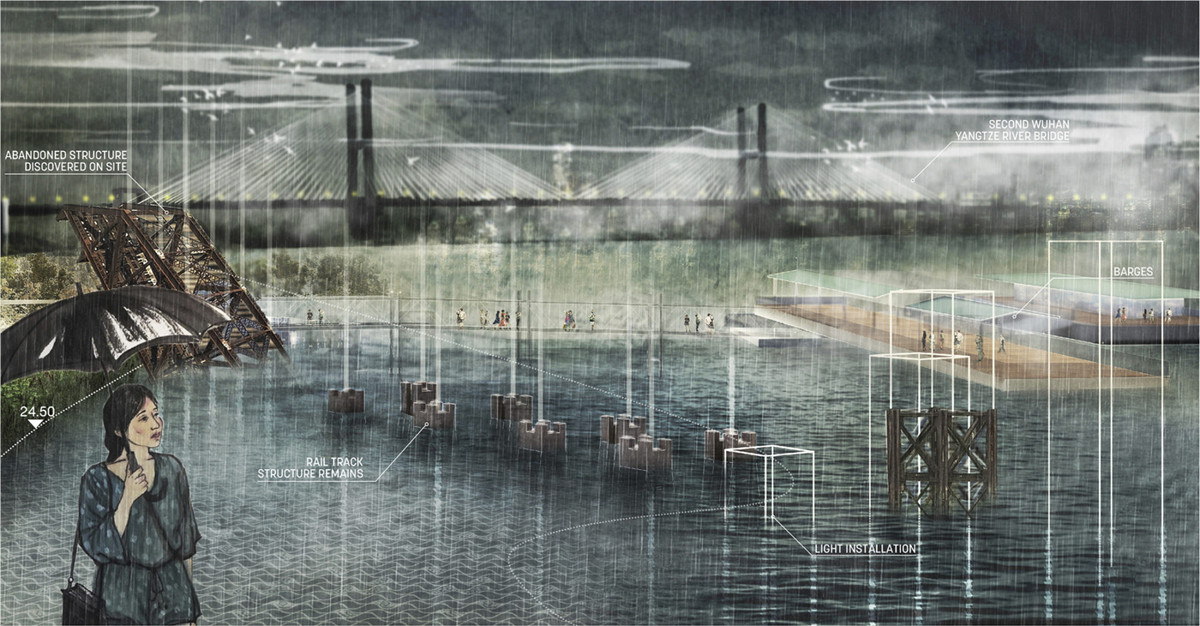
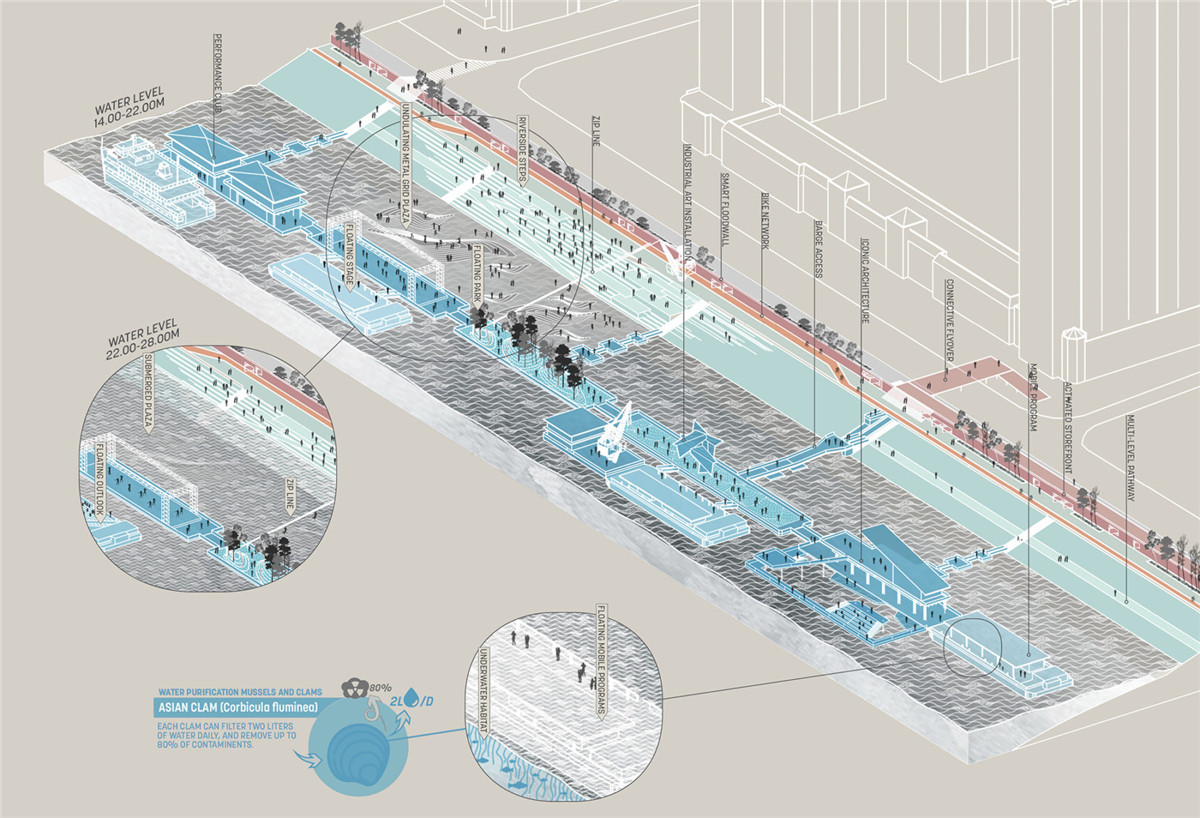
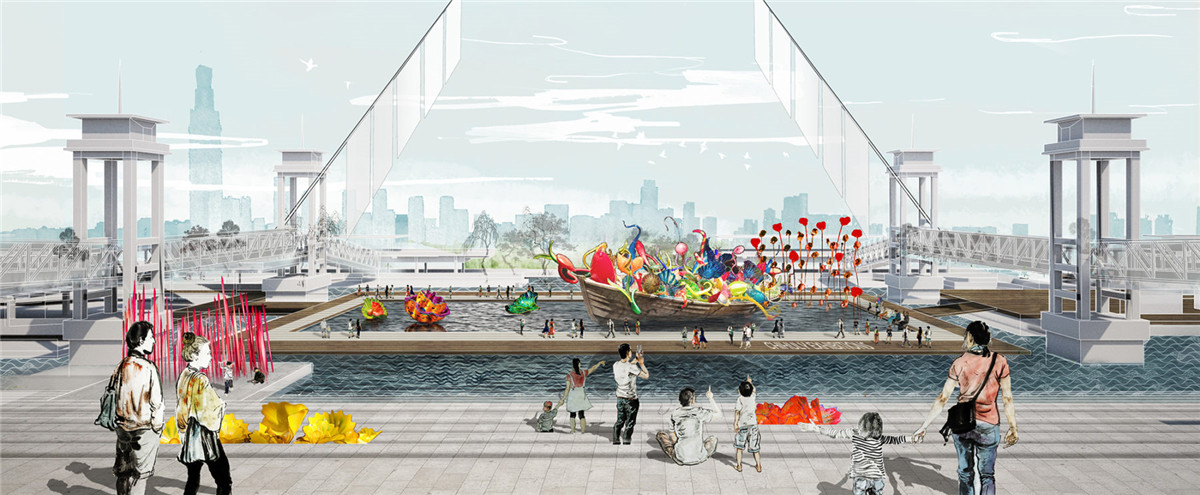
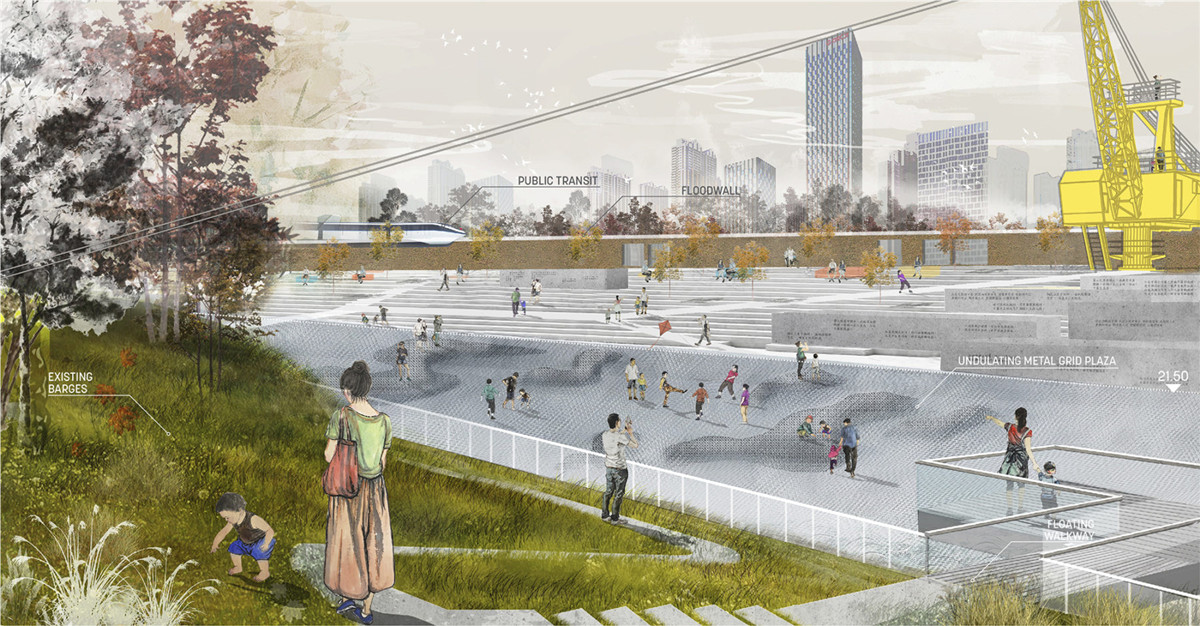
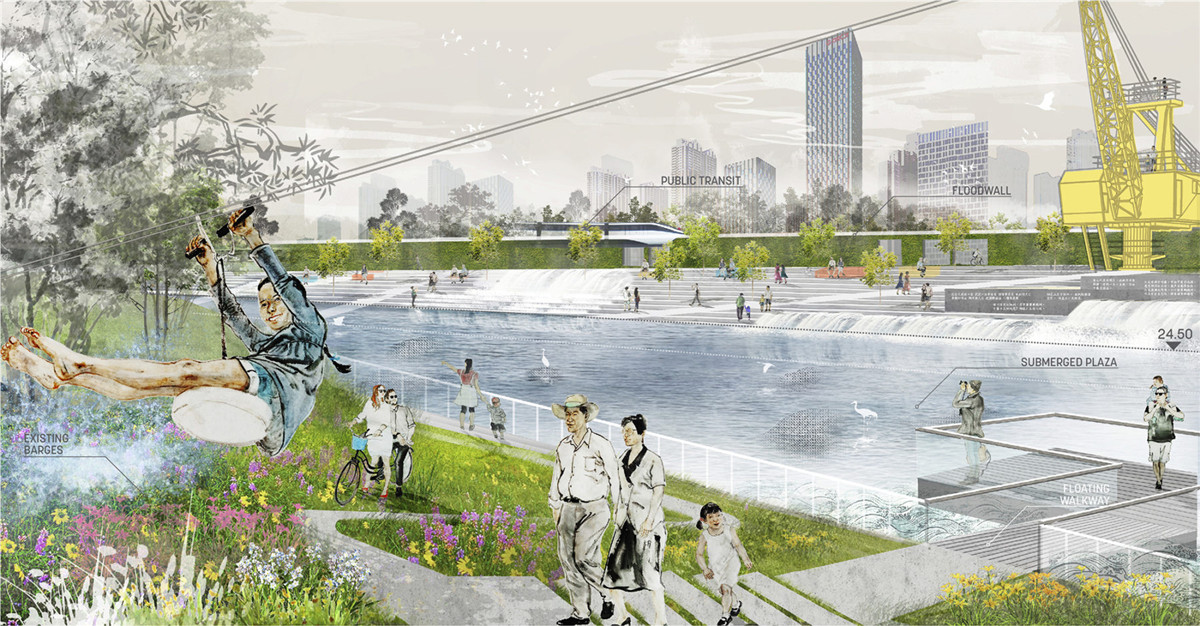
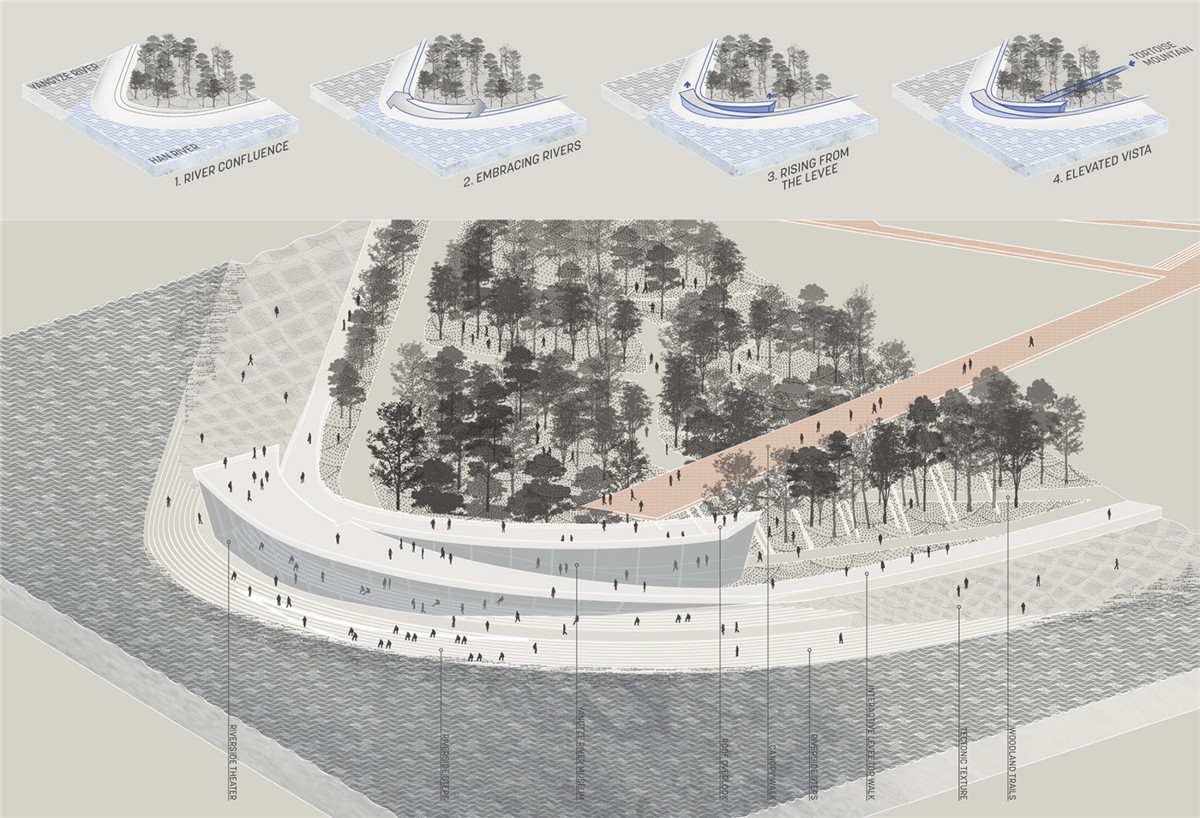
Wuhan’s rich industrial history is also celebrated, with historical landmarks highlighted throughout in the riverfront park. Though largely abandoned, the site’s massive railyards and remnants of freight train ferry terminals have a strong visual presence. This heavy-duty infrastructure offers engaging platforms for park visitors to more intimately experience the river, while a series of barges are connected to form a floating promenade. This promenade rises and falls with the river, and delineates a uniquely dynamic space in between. The design of the riverfront park repurposes these industrial relics as vibrant waterfront hubs of new cultural and recreational uses, including floating plazas, restaurants, galleries, and even a floating community garden.
武汉丰富的工业历史也备受赞誉,河滨公园内到处都是历史地标。 虽然大部分被遗弃,但该站点的大型铁路站场和货运列车渡轮码头的遗迹具有强烈的视觉存在感。 这个重型基础设施为公园游客提供了引人入胜的平台,让他们更亲密地体验河流,同时一系列驳船连接起来形成一个漂浮的长廊。 这条长廊随河流起伏,在两者之间划定了一个独特的动态空间。 滨河公园的设计将这些工业遗迹重新用作新的文化和娱乐用途的充满活力的滨水中心,包括浮动广场、餐厅、画廊,甚至是浮动社区花园。
At the iconic “Tip of China”—the peninsula at the scenic confluence of the Yangtze the Han rivers—the distinct color of the water of the two rivers clash abruptly with a clearly visible boundary in the middle of the Yangtze. Here, the Museum of the Yangtze rises from the levees and offers an uninterrupted panorama of Wuhan’s waterfront and burgeoning skyline.
在标志性的“中国一角”——风景秀丽的长江与汉江交汇处的半岛——两河水的鲜明色彩与长江中部清晰可见的分界线突然碰撞。 在这里,扬子江博物馆从堤坝上拔地而起,提供了一个不间断的武汉海滨和新兴天际线的全景。
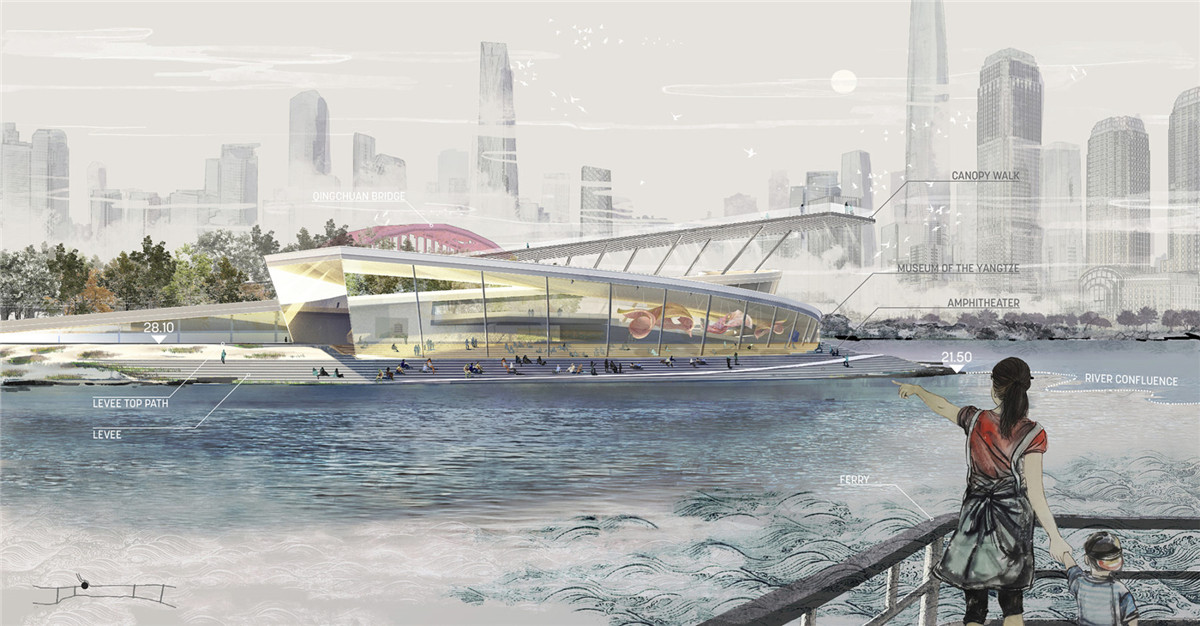
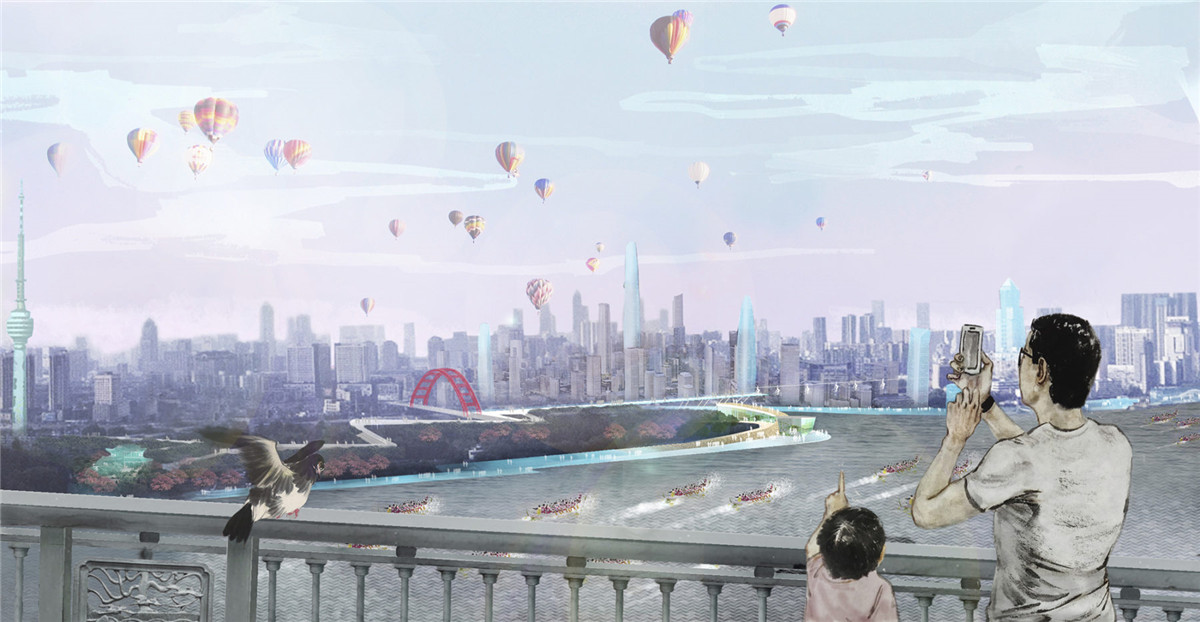
SEE MORE (来自) Sasaki
